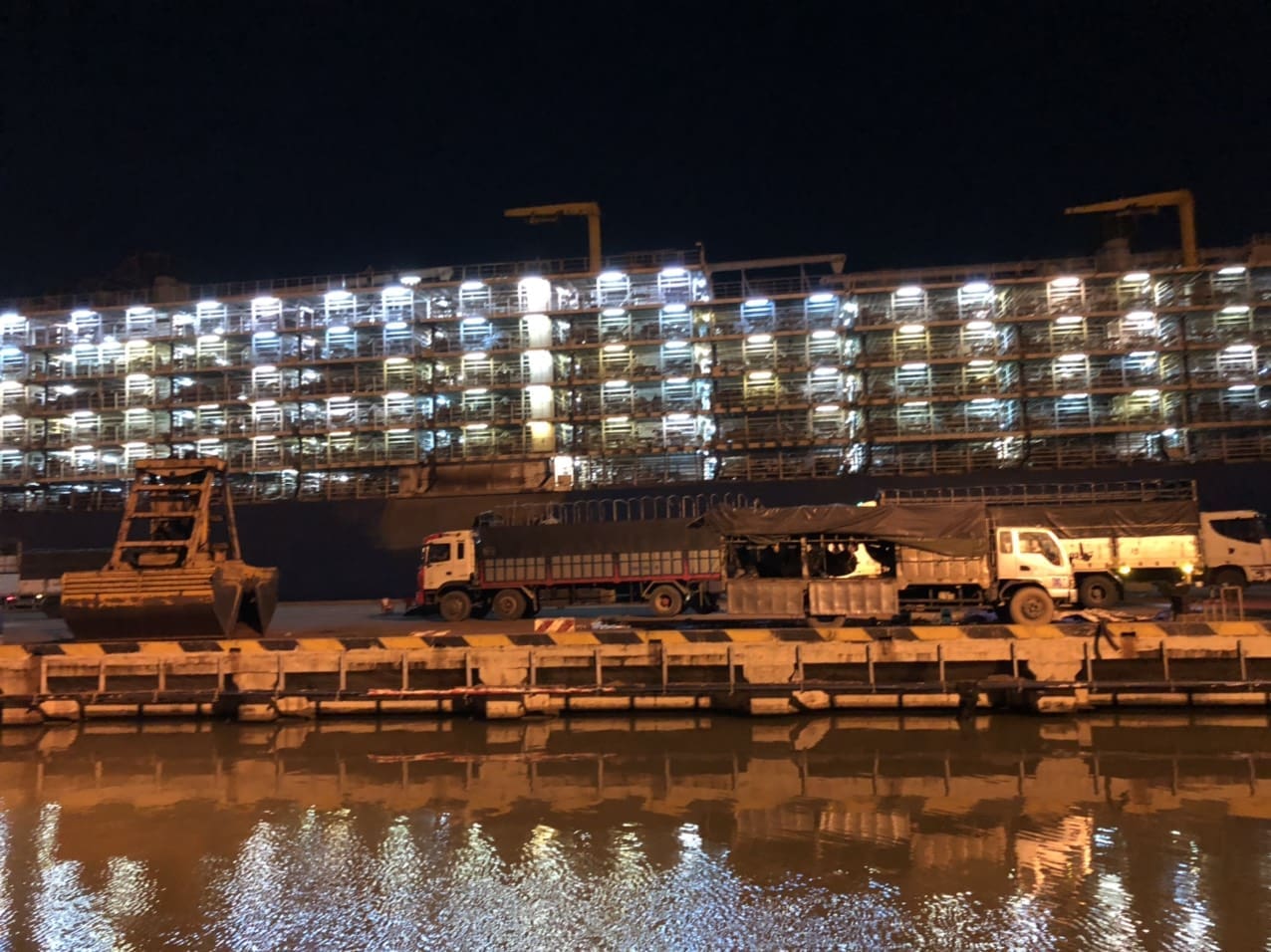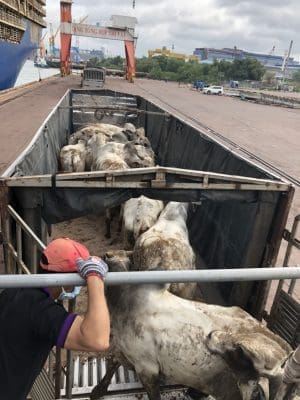In the wake of the first large shipment of bulls from Brazil arriving in Vietnam, one of Australia’s largest markets for live cattle, Dr Michael Patching and Dr Rodd Dyer explore potential implications for Australia’s cattle export trade.

The MV Nada discharging in Vietnam.
14,000 head of cattle arrived from Brazil into the port of Thi Vai just outside Ho Chi Minh City in southern Vietnam on the 23rd September.
While shipments of breeder cattle from South America into Asia are not uncommon, this shipment was a first for slaughter beef cattle from South America to south-east Asia and followed years of conjecture over the feasibility of such an operation.
Reports from a source associated with the shipmentndicate that the shipment was a resounding success. The cattle arrived healthy and mortality rates onboard were approximately 0.2%. This is lower than the Australian Standards for the Export of Livestock (ASEL) reportable limits of 0.5%. It is important to note that the shipment experienced fortunate weather when rounding the Cape of Good Hope in South Africa and this would have contributed to the positive outcome.
The cattle reportedly arrived about AUD 60 cents cheaper per kg liveweight than Australian cattle, not accounting for tax or quarantine costs. This is a combination of cheaper Brazilian cattle due to the weakness of the Brazilian Real, and the record high prices of Australian cattle.
The successful first shipment has stimulated interest from Vietnamese importers to obtain import permits. It is our understanding that several companies have now been provided approval to import cattle from Brazil including some significant importers of Australian cattle. There are reports that cattle are already being aggregated in Brazil for the next shipment.
For the Australian trade the short-term implications are that there will now be very few, if any shipments of feeder or slaughter cattle from Australia to Vietnam until after the Tet Lunar New Year holidays at the beginning of February 2022. The market is already overstocked with Australian cattle due to an unprecedented drop in demand, and challenges getting beef to consumers in traditional supply chains due to the recent and severe COVID lockdowns and movement restrictions. This easing of demand may further assist the Brazilian cattle get a foothold into the market. The small margins in slaughter cattle trade mean that large vessels such as the Nada must be used which under normal trading conditions and higher abattoir throughput this may have resulted in a disrupted trade. This may not now be the case.
The implications for the Australian trade will still be dependent on a few factors:
- Increasing oil prices. The recent surge in oil prices may result in changes to the trade feasibility due to higher shipping costs and will likely have the most significant impact on the competitiveness of subsequent voyages in the short term.
- Performance of subsequent voyages. The first shipment demonstrated competitive prices and the lack of regulatory requirements imposed on trading from Brazil – compared to Australian cattle under ESCAS – probably means it will take several incidences of high mortality or poor performance, or significantly high prices in subsequent shipments for Vietnamese traders to reconsider the trade.
- The actual performance of the cattle in the market. It is expected that the Brazilian cattle will compete closely with Australian cattle in the market. As the Brazilian cattle are all bulls they will have less exposure to over-fatness losses from processing delays.
- Reopening of the official Laos-China border trade. There may be some interesting implications for global trade dynamics due to this new trade channel. Investments into quarantine and trade infrastructure for official beef cattle exports from Laos to China have been completed and trial shipments have already been run in early 2021. Whilst recent Lumpy Skin Disease outbreaks and COVID travel restrictions have temporarily closed the Laos-China cattle trade, the desire from China is to import 500,000 head of cattle annually through this channel. Due to ESCAS requirements and current Australian Chinese relations it is unlikely that Australian feeder or slaughter cattle will go through this route. Certainly, in the short-term. However, this may create an opportunity for South American cattle. If any cattle can politically and feasibly enter this trading channel then this would likely have a positive impact on the regional livestock trade mainly due to the introduction of stricter animal diseases control programs. The prospect of the Laos-China trade is already having profound impacts on investment into the cattle industry in the region, especially in Laos.
- The introduction of Brazilian beef into Vietnam. It is an open secret that one of the reasons for Brazilian cattle exports is to work towards gaining market access for beef imports into Vietnam. If beef exports are granted the impact to both local production and processing, as well as the trade of livestock from Australia to Vietnam, would be significant.
So, what can Australia do?
The Australian ESCAS regulations have created some significant improvements in animal welfare outcomes in Vietnam, such as routine stunning now being ubiquitous. However, ESCAS adds significant transaction costs that can at times strain or complicate trading relationships. Brazilian cattle will be able to exploit this during periods of limited supply and high prices. Initiatives like LGAP were designed to address this limitation by allowing relatively natural and open market trading instead of restricted supply chains. Exporters will now need to look for innovative whole-of chain compliance approaches to decrease the burden on their supply chains while still ensuring animal welfare outcomes… which LGAP implementation demonstrated is not easy.

Braziling bulls during unloading in Vietnam.
More importantly we need to re-evaluate how we are operating in some of these markets. In the long term there is the chance that when Australian prices ease again that quality Australian cattle may be a preferable to imports from Brazil. However, Australia’s reliance on what is essentially a trading relationship has been exposed by COVID-induced disruptions to business relationships, cattle supply-price pressures, and a new competitor. Deeper investment and partnerships in well thought out, structured and complementary services, education, and knowledge transfer in the Vietnamese red meat sector would elevate Australian industry beyond exploring our cattle relationship as a value-based measure. Options include extension of the Australian eating quality grading, cut specifications, Ausmeat language and quality assurance systems, livestock traceability, support with epidemic control programs, abattoir staff training for working visas etc. Making these default within the Vietnamese Government and industry would create stronger linkages and help protect both beef and cattle interests in the region well beyond competitiveness of Australian cattle alone.
Finally, a critical next step is for Australian and Vietnam investors and stakeholders in the cattle and beef trade to urgently re-engage and explore concrete options to address the current challenges facing the sector. To support this, grant funding from the Department of Foreign Affairs and Trade under the Australia-Vietnam Enhanced Economic Engagement Grant (AVEG) Program 2021 has been provided to develop a bilateral investment Blueprint for Action for the Australian–Vietnam cattle sectors. AVEG aims to advance Australia’s international economic interests through bilateral engagement on trade and investment policy priorities of the Australian Government. The Blueprint for Action grant will support consultation and engagement with commercial, industry and Government stakeholders in Australia and Vietnam via a series of roundtables and events to identify strategic priorities for investment in this new trading environment.
Everyone from producers, industry or Government groups, to technology start-ups are invited to contribute to developing and shaping the Blueprint or to understand how to get involved in investing in the Australian-Vietnamese cattle sector a business. Please contact myself Dr Michael Patching mpatching@altafoodagri.com
This activity received grant funding from the Department of Foreign Affairs and Trade under the Australia-Vietnam Enhanced Economic Engagement Grant Program 2021.

